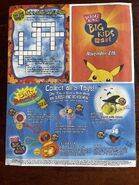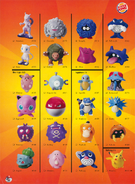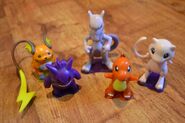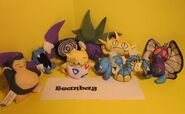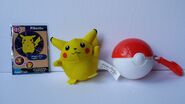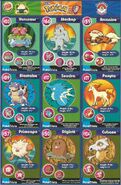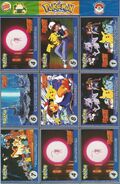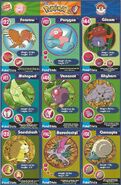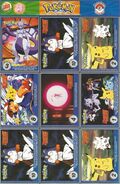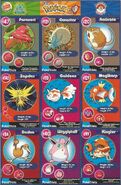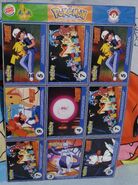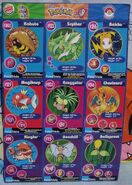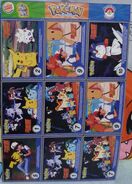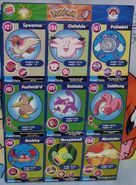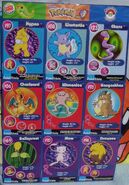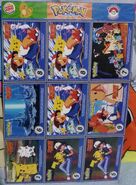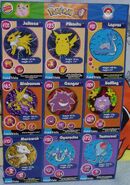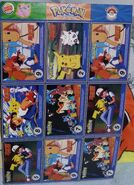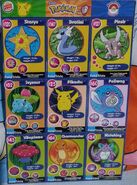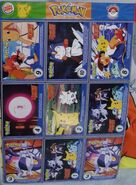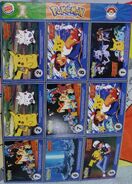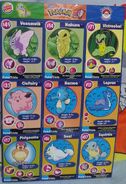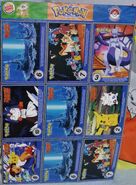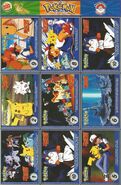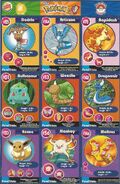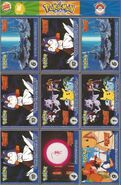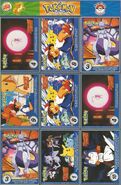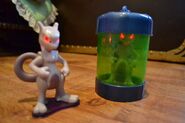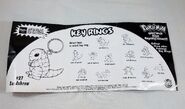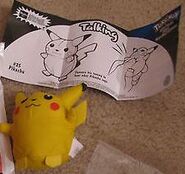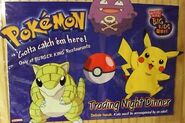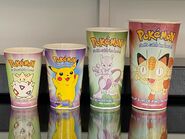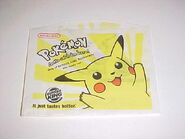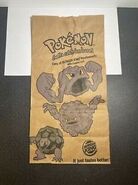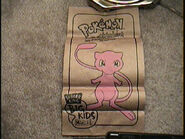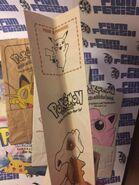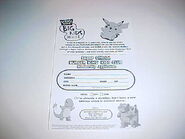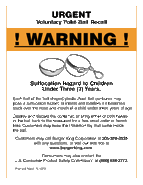About[]
On November 8, 1999, Burger King had offered a set of 59 toys based on Pokémon (Key-rings, squirters, rev-tops, launchers, talking plush, light-ups and Poké beanbags) inside a Pokéball container and with one of the 151 trading cards. The promotion ended on December 31, 1999.
Toys & codes[]
Below is the list of the 59 toys, ordered by their category in alphabetical order (Key-rings, launchers, light ups, etc.) and listed according to their Pokédex entry.
If you have an unopened bag, each toy has its respective code, which you can check on the bottom left of your sealed bag. If you have doubts about which toy is inside your bag, first check this code list.
Key-Rings[]
(70-15) Sandshrew.
(38-11) Sandslash.
(46-12) Nidoqueen.
(54-13) Nidorino.
(52-12) Nidoking.
(96-18) Vileplume.
(94-18) Geodude.
(44-11) Muk.
(62-14) Cubone.
(78-16) Hitmonlee.
(86-17) Kangaskhan.
(56-13) Electabuzz.
(60-13) Dragonite.
Launchers[]
(71-15) Bulbasaur.
(79-16) Venusaur.
(39-11) Nidoran.
(95-18) Arcanine.
(87-17) Rapidash.
(47-12) Slowpoke.
(55-13) Rhyhorn.
(63-14) Tauros.
(00-18) Lapras.
Light-ups[]
(57-13) Charmander.
(73-15) Raichu.
(41-11) Gengar.
(97-18) Mewtwo.
(89-17) Mew.
Poké Beanbags[]
(99-18) Butterfree.
(91-17) Golbat.
(75-15) Oddish.
(51-12) Meowth.
(43-11) Poliwhirl.
(83-16) Gyarados.
(59-13) Snorlax.
(67-14) Togepi.
Rev-tops[]
(84-16) Clefairy.
(66-14) Jigglypuff.
(82-16) Venonat.
(76-15) Diglett.
(90-17) Graveler.
(58-13) Golem.
(50-12) Magnemite.
(42-11) Voltorb.
(68-14) Koffing.
(74-15) Chansey.
(92-17) Tangela.
(98-18) Ditto.
Squirters[]
(64-14) Squirtle.
(80-16) Blastoise.
(40-11) Psyduck.
(65-14) Poliwag.
(81-16) Poliwrath.
(72-15) Tentacruel.
(48-12) Shellder.
(88-17) Seadra.
(49-12) Kabuto.
Talking[]
(34-10) Pikachu A: Says "Pikachu" when pressed.
(35-10) Pikachu B: Says "Pika-chu" when pressed.
(36-10) Pikachu C: Says "Pika Pika Pika" when pressed.
Poketrivia[]
Bulbasaur: What was planted on Bulbasaur's back at birth? - A bulb that becomes a large plant
Ivysaur:
Gallery[]
In this gallery you'll find everything related to the promotion: complete collections of toys, gold plated cards, trading cards and master sheets.
Also there are all kind of stuff that were in the restaurants at the time: cups, bags, crowns, checklists, sealed packages, instruction booklets, restaurant papers, magazines, store signs and displays, posters, uniforms and anything you can imagine.
It's recommended to read the description of each image to have greater knowledge of this promotion...enjoy.
Accidents & recall[]
Jill Ann Alto is a single mother who lives in Sonora, California, with her daughters: a five-year-old, a four-year-old and 13-month-old Kira Alexis Murphy. Like many families, they also went to Burger King for the Pokémon promotion and that's how they got their toys.
On Saturday, December 11, 1999, while his daughters were playing and Kira was in her playpen, Alto decided to take a shower, and then feed and dress Kira. While Alto was taking a shower, Kira took the red half of the Burger King pokéball and put it on her face, but when she inhaled, the plastic was sealed between her nose and mouth...20 minutes later, Alto came out of the bathroom and that's where his family's life changed forever: she founds Kira dead in her playpen with the pokéball red half covering her nose and mouth. Despite the fact that she managed to remove the plastic, there was nothing to do, Kira died of suffocation. His other daughters witnessed the death of their little sister.
After Kira’s death, and in the words of Russ Rader, spokesman for the U.S. Consumer Product Safety Commission, and Charles Nicolas, a Burger King spokesman, the fast food chain didn't want to recall the pokéballs or cease their distribution, because it wasn't concluded that the ball was the cause of the incident. Federal regulators from the Consumer Product Safety Commission also criticized Burger King for waiting to recall the containers. The problem became even bigger for the Miami-based chain, because the following text can clearly be read at the bottom of each toys packaging: “Safety tested and recommended to children of all ages”.
What seemed to be a totally successful promotion ended up being a two-edged weapon: the most ambitious campaign in its entire history, in which they invested $22 million dollars, was becoming a headache. And not only because of the frequent shortages of Pokémon toys in all its restaurants or the disappointment and complaints from its customers when they left empty-handed, but because of the legal and economic problems they had to go through as a result of the incident.
On Thursday, December 23, 1999, in Leavenworth, Kansas, an 18-month-old girl nearly suffocated with another ball, but her dad saw her in time and, successfully, pulled off the plastic from her face. During this accident, the girl's lips turned blue. The next day, Burger King ordered to all their restaurants to discontinue the pokéball container distribution. From that moment, and in each kids meal order, Burger King employees had to open the packages, remove the pokéball and put the toy and the card in the package. Despite the insistence of many parents, who begged to include the containers because there were no children under three living in their homes, the employees had to keep the balls.
This was a very hard hit for the campaign and for many children, because some things that made this promotion special was the mystery for discover which toy was inside the pokéball, carrying it or put the ball in their backpacks. After the 18-month-old girl almost suffocated, and Kira’s death, frustration from not only the babies parents but from other Burger King fans were over the roof, heavy criticism began and the fast food chain was losing popularity. This left Burger King with no choice but to begin a recall for the pokéball containers, starting Monday, December 27, 1999.
Over 25 million units were destroyed. The burger chain offered that if the ball was returned, returners could get a free order of small fries for the toy. A commercial began airing and warnings were included in meal packs. It was the largest recall of any children’s product since 19 million swimming pool dive sticks were recalled on June, 1999.
Once the toy was recalled, however, Burger King issued a news release, took out an advertisement in USA Today and placed posters in its 8,000 stores that, in those days, it had nationwide. Also, they worked with the Consumer Product Safety Commission on ways to reach more potential owners of the toys. Added to that, the king’s chain mailed posters to 10,000 emergency rooms, 56,000 pediatricians and 25,000 clinics. As well, produced tray liners and bags with a recall notice and posted recall information on hundreds of Pokémon Web sites and chat rooms that had popped up continually since the Pokémon craze began. Their efforts at reaching consumers were admirable. The Pokémon promotion ended between Friday, December 31, 1999, and Sunday, January 2, 2000.
Zachary Jones is a 4-months-old baby who lives with his mother, 15-years-old Ashley Jones, his step-grandmother, 33-years-old Sheila Jones, and his grandfather, Michael Jones. Their live in Lawrence, a suburban on Indianapolis northeast side. His father, Brian Whitis, 19-years-old, lives nearby their house.
On Tuesday, January 25, 2000, Zachary awakened around 6:00 a.m. and 7:00 a.m. To make him calm, his step-grandmother left the pokéball in his crib. Two hours later, at approximately 9:00 a.m., she checked on the child and founds him unresponsive, with a pokéball half covering his mouth and nose. She quickly pulled off the container, but on his face it was noticeable where the plastic had been around, because of the redness it left on him. The step-grandmother performed cardiopulmonary resuscitation on him, but without success. After this, she called an emergency medical team, who also tried to help him, but they also were unable to revive him. Moments later, he was pronounced dead in a hospital.
Despite all the Burger King's efforts on prior weeks, Zachary's family didn't know about the pokéball recall. After the accident, his grandfather mentioned that he was still incredulous by the way the boy had the pokéball on his face and he also couldn't believe the fact to find something to eat for the children and ended up bringing home a lethal toy.
The next day, on Wednesday, January 26, 2000, an autopsy was performed on Zachary Jones. A Deputy Chief of the Lawrence Police Department, Lana Schneider, said a 4-month-old baby cannot move things from their face, and basically it suffocated. The step-grandmother revealed that she knew what she was doing and that she believed the container was safe.
During that day, Charles Nicolas commented that Burger King learned of the death that morning through news reports and they would investigate the matter. For that, the fast food chain did a second wave of advertising, which this time included radio ads, since it was difficult to know how many containers were still in the houses.
Pokémon had gone on to have had more promotions at Burger King, such as Pokémon: One more chance to catch 'em all (2000), Pokémon 2000 Power Cards (2000), Mini Game Boy Color Collectibles (2000), Pokémon World plushies and watches (An UK and Latin America countries promotion launched around 2000-2001), Diamond & Pearl TCG accessories (2008), Platinum TCG accessories (2009) and Detective Pikachu toys (2019), but none of them included pokéballs since the three incidents. Although this has been largely forgotten, it still remains the darkest event that happened in Burger King.

Burger King Pokemon Toys Recall Commercial
The commercial/PSA that warned parents over the Pokémon pokéball; telling them it may pose a suffocation hazard to children under 3. The PSA also tells parents to throw the ball away or return it to Burger King. This began airing from December 28, 1999, to January 2000.
Lawsuits against Burger King[]
Insert text here.
Lawsuit #2
Scott Pace, Diane Bubonic and their children enjoyed the Burger King Pokémon promotion in Orange County, California. Their children didn’t have any accidents related to the pokéball containers, but on Monday, February 28, 2000, Pace and Bubonic went to the San Francisco Superior Court to sue Burger King, with the purpose that the company pay back millions of dollars to the customers who were “induced” into buying meals at the fast food chain. Both parents claimed they never would have bought the meals if they had known the toys were defectives.
The 11-page document stated these points:
* The lawsuit represented all children who "haven't suffered personal injury or property damage as a result of the Pokémon ball defective toy".
*Accused Burger King of "refusing" to start the recall until weeks after Kira Alexis Murphy suffocated on the ball.
*Sought punitive damages to punish Burger King for its alleged fraudulent actions, because the packaging on the toys stated that they were "safety tested" and appropriate for "all ages".
*The actual damage to each plaintiff is less than $25 (Although attorneys claimed that more than a million Burger King customers purchased Pokémon meals in California).
Attorneys for Pace and Bubonic petitioned a judge for class action status, hoping to represent consumers across the state. It should be noted that anyone who was injured or killed by a Burger King pokéball wasn't covered by this lawsuit.
During that week, on Friday, March 3, 2000, attempts were made to contact people involved in the case, but without success: Patrick Catalano (The attorney who filed the lawsuit in San Francisco) could not be reached, while a Burger King spokeswoman didn’t return a call.
Ten days later, on Monday, March 13, 2000, and to promote the Pokémon: The First Movie VHS and DVD launches, Burger King relaunched their 1999 Pokémon promotion, renaming it Pokémon: One more chance to catch ’em all. The 59 toys were available again, and although they didn't include any plastic container, was a big chance to complete this set. The promotion ended on Sunday, March 26, 2000, being a success (To learn more about this second promotion, click on the blue words in this paragraph).
Lawsuit #3
On Thursday, May 4, 2000, and almost five months after Kira Alexis Murphy’s death, her family filed a wrongful death lawsuit in Los Angeles, California, against Burger King (The fast-food chain), Equity Marketing Inc. of Beverly Hills (The maker of Burger King pokéball containers) and Delaware-based Specialized Technology Resources Inc (A safety-testing company hired by Burger King to do safety studies).
During the lawsuit, Jill Ann Alto (Kira’s mother) said that when she came out of her shower, she found her daughter with half of the pokéball container covering her face and, tearful, said that she tried to pull it off but there was nothing to do. Geoffrey Wells, Alto’s attorney, said they hold Burger King responsible for Kira’s tragic death and that putting holes in the containers would have prevent any child from suffocating.
Later that day, the defendants offered few comments about the lawsuit: Charles Nicolas (Burger King spokesman) said they couldn't comment about the case because the fast-food chain attorneys hadn't yet reviewed the lawsuit, no one from Specialized Technology Resources Inc. was available to comment, while Ria Carlson (An Equity Marketing Inc. spokeswoman) said the toys were rigorously tested beyond federal requirements. She also mentioned that as tragic as this was, she considered it an accident because this was the first death related to any of their billion produced items.
While in those days were offering their Flintstones in Viva Rock Vegas kids meal promotion, Burger King still faced problems derived from their Pokémon ambitious promotion, extending them for almost half a year, because the shortages of toys during the first days of the campaign also were a headache.
More than 24 years have passed since these lawsuits were filed, and as of January 2024, their verdicts are unknown.

